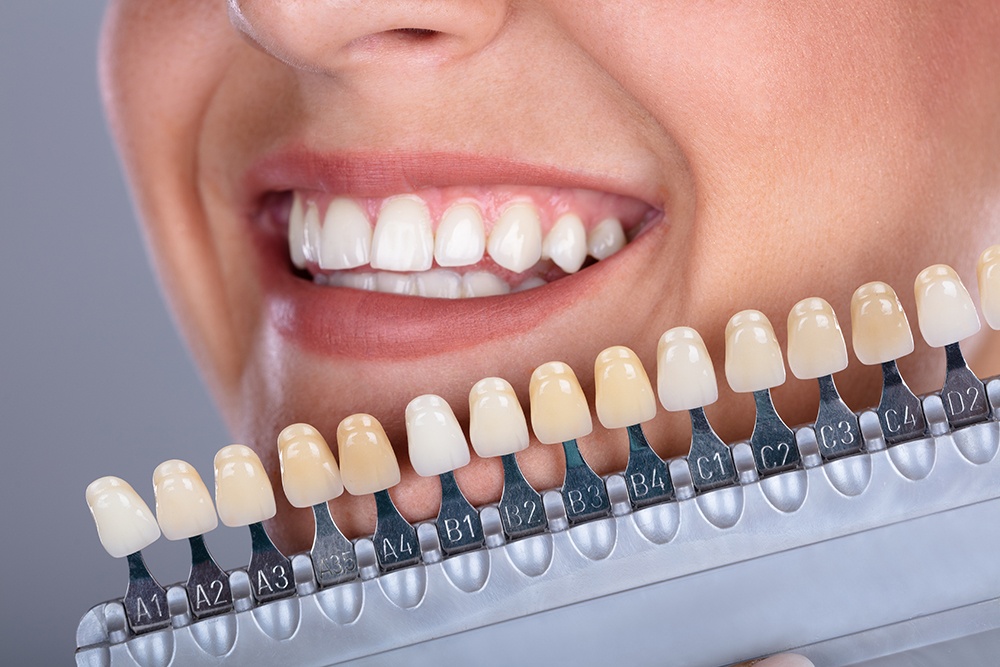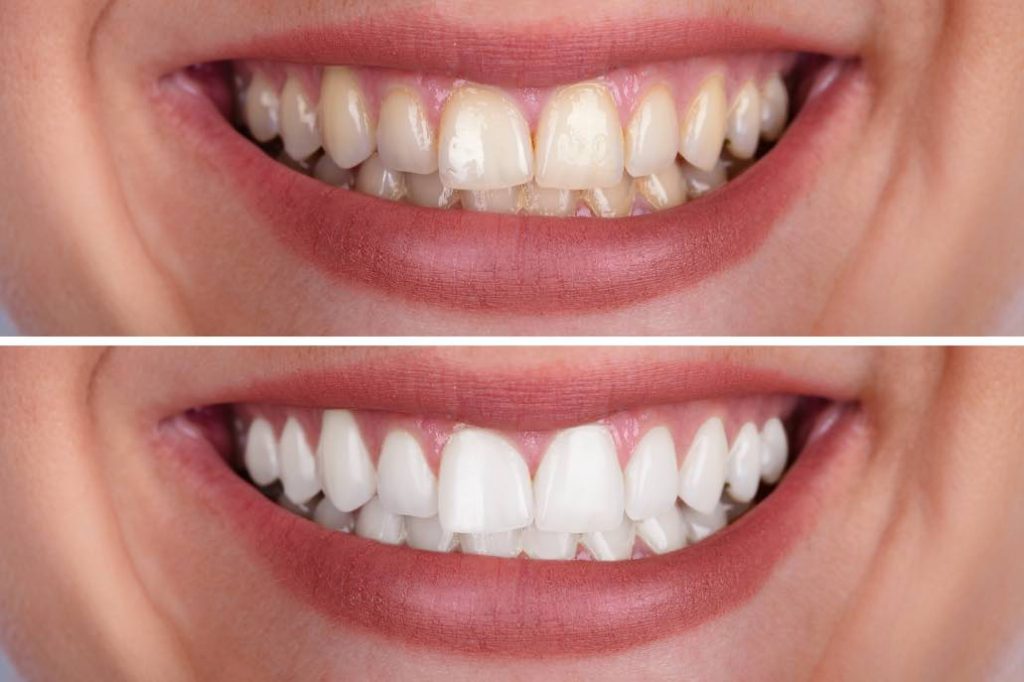Teeth whitening for sensitive teeth requires gentle methods and suitable products. Sensitivity demands extra care during the whitening process.
Having sensitive teeth shouldn’t deter you from achieving a brighter smile. With advancements in dental care, various products and techniques cater specifically to those with tooth sensitivity. These options include specially formulated whitening toothpaste, at-home kits with milder bleaching agents, and professional treatments utilizing desensitizers.
It’s essential to approach teeth whitening cautiously by selecting products designed for sensitive teeth, to minimize discomfort. Before embarking on any whitening regimen, consulting with a dentist can provide personalized advice and ensure that the chosen method is safe and effective for your dental health. By taking the right precautions, individuals with sensitive teeth can still enjoy the confidence boost that comes with a whiter, brighter smile.

Credit: www.smilepointdentalvictoria.com
Introduction To Teeth Whitening
Teeth whitening is a popular cosmetic procedure. It removes stains and discoloration, enhancing the brightness of your smile. For those with sensitive teeth, understanding options and methods is crucial. Let’s explore gentle yet effective teeth whitening solutions for sensitive teeth.
Understanding Teeth Whitening
Teeth whitening involves bleaching the teeth to lighten their color. It can be done professionally or at home. The key ingredient is usually hydrogen peroxide or carbamide peroxide. These compounds break down stains, making the teeth appear whiter.
- In-Office Whitening: Performed by a dentist, quick results.
- At-Home Kits: Custom trays or strips, used over time.
- Natural Remedies: Baking soda or fruit peels, milder effects.
Overview Of Teeth Sensitivity
Teeth sensitivity happens when tooth enamel wears down or gums recede. This exposes the dentin, a sensitive layer underneath. It can cause discomfort or pain when exposed to hot, cold, sweet, or acidic foods and drinks.
| Causes | Common Triggers |
|---|---|
| Worn Enamel | Hot Drinks |
| Receding Gums | Cold Ice Cream |
| Dentin Exposure | Sugary Snacks |
Causes Of Tooth Sensitivity
Are your teeth sensitive? You’re not alone. Many people feel tooth pain when they eat, drink, or brush. Let’s see what’s behind this sting.
Enamel Erosion And Dentin Exposure
Think of enamel as a shield for your teeth. It’s super tough, but not unbreakable. Sometimes, this shield wears down. This is called enamel erosion. What makes enamel fade away? Here’s a quick list:
- Too much soda or fruit juice – the acids can hurt enamel.
- Hard brushing – if you press too hard, it can harm.
- Teeth grinding – it’s like sanding your teeth at night.
When enamel wears down, dentin gets exposed. Dentin has tiny tubes that lead to the nerve. This can make teeth hurt with hot or cold food.
Gum Recession And Root Exposure
Gums protect roots of the teeth. But sometimes, they pull back. That’s gum recession. Why do gums recede? Let’s unpack the reasons:
- Gum disease – germs can make gums angry and shrink.
- Age – gums can wear out as we get older.
- Hard brushing – pushing too hard can push gums up.
When gums go up, roots come out. Roots don’t have enamel to protect them. So they’re more likely to be sensitive. Especially to hot and cold things.
Tooth sensitivity can certainly put a damper on enjoying your daily cup of joe or ice cream treat. Understanding these causes is the first step in finding relief and brightening your smile while keeping discomfort at bay.
Types Of Teeth Whitening Options
Sparkling smiles attract every eye. For sensitive teeth, the right whitening method promises a dazzling look without the ouch. Let’s explore options tailored for tender teeth.
Professional In-office Whitening
Quickest results come from the dentist’s chair. Dentists use high-grade bleach and tools. It’s safe for sensitive teeth. Treatments often take under an hour. Dentists might use special guards or pastes to protect sensitive gums. Ask about desensitizers like fluoride or potassium nitrate to lessen sensitivity.
At-home Whitening Kits
Convenience meets comfort in your home. At-home kits range from strips to LED devices. Choose products with lower peroxide levels for sensitivity. Follow instructions carefully. Overuse can increase tooth sensitivity. Don’t rush results. Slow and steady brightens safely.
Natural Whitening Methods
- Baking soda gently erases stains. Brush with it twice a week. Don’t scrub hard.
- Oil pulling with coconut oil may pull out impurities. Swish gently for best results.
- Charcoal turns some smiles bright. Use with caution as it can be abrasive.

Credit: www.distinguished-dental.com
Impact Of Whitening On Sensitive Teeth
Bright smiles often come with a quest for whiter teeth. For those with sensitive teeth, however, this quest can come with its challenges. Teeth whitening for sensitive teeth requires a delicate balance between efficacy and comfort. Understanding how whitening treatments can affect sensitive teeth is crucial in maintaining oral health while achieving that coveted sparkle.
How Whitening Agents Affect Sensitive TeethHow Whitening Agents Affect Sensitive Teeth
Teeth whitening products typically contain bleaching agents like hydrogen peroxide or carbamide peroxide. These agents work by penetrating tooth enamel to break down stains. Sensitive teeth, with exposed dentin or worn enamel, can experience heightened sensitivity as these agents come into contact with the teeth. It’s vital to choose a product specifically designed for sensitive teeth to avoid unnecessary discomfort.
Adverse Reactions to Watch ForAdverse Reactions To Watch For
Sensitivity isn’t the only concern when it comes to teeth whitening. Certain adverse reactions can occur, especially if products are misused. Be on the lookout for signs like:
- Gum irritation: A common issue if bleaching gel comes into contact with the gums.
- Enamel damage: Overuse of whitening products can lead to enamel degradation.
- Uneven coloration: Whitening treatments might not work evenly, leading to spotted teeth.
It’s essential to follow the product instructions carefully and consult a dentist before starting any whitening treatment, especially for those with sensitive teeth.
Pre-whitening Care For Sensitive Teeth
Embracing a brighter smile should be exciting, yet for those with sensitive teeth, it often brings a sense of dread. Teeth whitening can cause discomfort to those with heightened sensitivity. But, with the right pre-whitening care, you can minimize discomfort and safely achieve that gleaming smile.
Assessing Your Level Of Sensitivity
Understanding your sensitivity level is crucial before considering any whitening treatment. To do this, you might:
- Keep a food diary to note down instances when sensitivity occurs.
- Visit your dentist for a thorough check-up.
- Test different temperatures on your teeth to gauge reaction levels.
Strengthening Tooth Enamel Prior To Whitening
Strong enamel is the foundation for comfortable whitening. A few preparatory steps include:
- Using toothpaste designed for sensitive teeth.
- Integrating fluoride treatments into your dental routine.
- Including calcium-rich foods in your diet to naturally fortify enamel.
Remember to maintain good oral hygiene to reduce sensitivity before whitening treatments. This includes gentle brushing and flossing regularly.
Choosing Products For Sensitive Teeth
Is teeth whitening a dream for those with sensitive teeth? Not at all. The key is to select the right products. Sensitive teeth need gentle yet effective ingredients. Start your journey towards a brighter smile with the proper teeth whitening tools.
Ingredients To Look For
Look for products with specific ingredients that protect enamel while they whiten. This ensures a pain-free experience.
- Potassium nitrate – reduces nerve sensitivity
- Sodium fluoride – fortifies tooth enamel
- Hydroxyapatite – rebuilds enamel and reduces sensitivity
Ingredients To Avoid
| Ingredient | Reason to Avoid |
|---|---|
| Alcohol | Can dry out the mouth, causing irritation |
| High concentration hydrogen peroxide | Can lead to increased tooth sensitivity |
| Sodium lauryl sulfate | Might cause or worsen sensitivity |
Whitening Techniques For Sensitive Teeth
Smiling should be a joy, not a pain. Teeth whitening for those with sensitive teeth requires special care. The right techniques ensure a bright smile without discomfort. Below are tailored whitening options for tooth sensitivity.
Customized Whitening Trays
Dental professionals often recommend custom trays. These trays fit your teeth perfectly. They protect gums from irritation. Whitening gel spreads evenly, reducing tooth pain. Here’s the simple process:
- Your dentist takes an impression of your teeth.
- Custom trays are created for a perfect fit.
- Whitening gel is applied inside trays.
- Trays stay in place, minimizing gel contact with sensitive areas.
Low Concentration Bleaching Agents
A gentler formula means less sensitivity. Low-concentration bleaching agents reduce the potential for discomfort. These agents take a bit longer to whiten teeth. Patience brings results without the bite of sensitivity. Options include:
- Over-the-counter strips with lower peroxide levels.
- Professionally dispensed take-home kits with mild bleaching gel.
- Longer treatment periods with gentle agents to safeguard against sensitivity.
Using Desensitizing Gels And Toothpaste
Protect your teeth before and after whitening. Desensitizing products form a barrier. They shield the nerves in your teeth. This prep step is a game-changer for those with sensitivity issues. Follow these guidelines:
- Apply desensitizing gel or toothpaste two weeks before whitening.
- Continue using these products during the whitening process.
- Opt for a toothpaste tailored for sensitive teeth.
- Look for ingredients like potassium nitrate and fluoride in desensitizing products.
Preventive Measures During Whitening
Embarking on a teeth whitening journey can be thrilling, yet for those with sensitive teeth, it’s tinged with caution. The key to a luminous smile without discomfort lies in preventive measures during the whitening process. Let’s delve into effective strategies that protect your pearly whites while achieving that coveted brightness.
Managing Whitening Frequency And Duration
When it comes to whitening sensitive teeth, striking a balance is crucial. Overzealous treatments can cause undue stress on your dental enamel and exacerbate sensitivity. Adapting the frequency and duration of your whitening sessions is essential for a pain-free experience.
- Shorter sessions ensure minimal exposure to whitening agents.
- Longer intervals between treatments give teeth time to recover.
- Always abide by product guidelines; customized advice from your dentist trumps all.
Protecting Gums And Exposed Roots
The gums and exposed roots of teeth are particularly vulnerable during whitening. As these areas are more sensitive, it’s imperative to offer them extra protection.
| Preventive Strategy | Benefits |
|---|---|
| Use desensitizing gel or toothpaste | Forms a protective barrier over sensitive areas |
| Apply protective materials, like dental dams | Shields gums from harsh chemicals |
| Opt for whitening treatments with lower peroxide concentrations | Reduces potential for irritation and sensitivity |
Focusing on these protective practices ensures your teeth whitening experience is both effective and gentle. Partnering with your dentist for a custom-fitted approach maximizes benefits while safeguarding your oral health.
Post-whitening Care For Sensitive Teeth
Teeth whitening can brighten your smile. Sensitive teeth need extra care after. This guide helps you keep your teeth white. And it cares for your sensitive teeth.
Alleviating Sensitivity After Whitening
After teeth whitening, it’s common to feel some tooth sensitivity. It’s not permanent. This section offers tips to reduce discomfort.
- Use desensitizing toothpaste: Brush with it before and after whitening.
- Avoid hot and cold foods: Your teeth may be sensitive to temperature changes.
- Chew gum: Sugar-free gum helps produce saliva. Saliva can protect your teeth.
- Soft bristle toothbrush: Be gentle on your enamel. Soft bristles help.
Long-term Maintenance Of Results
To keep your teeth white, follow these steps. They also help with sensitivity.
- Keep up with oral hygiene: Brush twice a day. Floss daily.
- Regular dental check-ups: Visit your dentist every six months.
- Avoid stain-causing foods: Coffee, tea, and red wine can stain teeth.
:max_bytes(150000):strip_icc()/hlt-led-teeth-whitening-kits-test-crest-emulsion-light-tstaples-1398-9441e08241c441379207f8251d38ccb7.jpeg)
Credit: www.health.com
Conclusion
Brightening your smile doesn’t have to be a discomfort for those with sensitive teeth. By choosing the right products and methods, you can achieve a dazzling white smile without the pain. Remember to consult your dentist and embrace gentle, sensitivity-conscious options.
Start your journey to whiter teeth today, with confidence and care!

